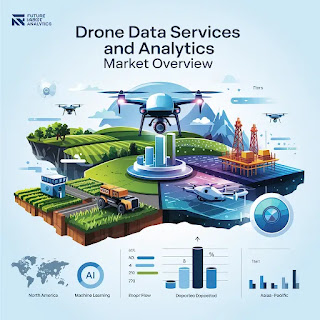The Soaring Heights of Drone Data Services and Analytics Market
The drone industry has evolved far beyond its early
applications in photography and recreation. Today, the drone data services and
analytics market represents one of the fastest-growing segments within the
broader drone ecosystem, transforming how businesses across industries collect,
process, and leverage aerial intelligence.
Explore the Full Report - https://futuremarketanalytics.com/report/drone-data-services-and-analytics-market/
Market Trajectory and Growth Projections
The drone
data services and analytics market is experiencing unprecedented growth,
with market valuations varying significantly across different research reports.
The drone data services market, valued at USD 3328.3 million in 2024, is
projected to reach USD 8141.4 million by 2032 with a CAGR of 56.4%. Meanwhile,
the broader drone analytics market shows equally impressive projections, with
the market valued at USD 9.07 billion in 2024 and expected to reach USD 68.50
billion by 2032, growing at a CAGR of 28.75%.
This explosive growth reflects the increasing recognition of
drone-generated data as a critical business asset. Organizations are moving
beyond viewing drones as mere data collection tools to understanding them as
comprehensive analytics platforms that can drive strategic decision-making.
Key Industry Applications
The power and utility sector has emerged as a dominant force
in the drone analytics market. The power and utility segment led the market in
2024, accounting for over 27% of the global revenue. This leadership stems from
the sector's need for efficient asset inspection, predictive maintenance, and
infrastructure monitoring across vast geographical areas.
Construction and urban planning represent another rapidly
expanding application area. 3D modeling will increase at the highest CAGR of
29.09% between 2024 and 2032, driven by increasing demand for precise
visualizations in construction, urban planning, and architecture. This growth
is fueled by the construction industry's need for accurate progress monitoring,
site surveys, and safety compliance documentation.
Technology-Driven Transformation
The integration of artificial intelligence and machine
learning with drone data analytics is revolutionizing how organizations extract
insights from aerial imagery. Advanced algorithms can now identify
infrastructure defects, monitor crop health, detect security threats, and
assess environmental changes with unprecedented accuracy and speed.
Cloud-based analytics platforms are democratizing access to
sophisticated drone data processing capabilities. Small and medium enterprises
can now leverage the same advanced analytics tools that were once exclusive to
large corporations, leveling the competitive playing field across industries.
Market Challenges and Opportunities
Despite robust growth projections, the market faces several
challenges. Regulatory compliance remains complex, with varying requirements
across different countries and applications. Data privacy concerns,
particularly in urban environments, require careful navigation. Additionally,
the need for skilled professionals who can interpret and act on drone-generated
insights creates a talent gap in many organizations.
However, these challenges present opportunities for
innovation. Companies that can streamline regulatory compliance, enhance data
security, and provide user-friendly analytics platforms are well-positioned to
capture significant market share.
Future Outlook
The drone data services and analytics market is poised for
continued expansion as organizations increasingly recognize the value of aerial
intelligence. The convergence of improved drone hardware, sophisticated
analytics software, and expanding regulatory frameworks creates a favorable
environment for sustained growth.
As businesses seek competitive advantages through
data-driven insights, drone analytics will become an essential component of
modern enterprise strategy. The market's evolution from a niche technology
sector to a mainstream business solution reflects broader trends toward
digitalization and intelligent automation across industries.
The next phase of growth will likely be characterized by
increased integration with Internet of Things (IoT) ecosystems, real-time
processing capabilities, and enhanced autonomous data collection systems.
Organizations that embrace these technological advances will be best positioned
to harness the full potential of drone-generated intelligence.




Comments
Post a Comment